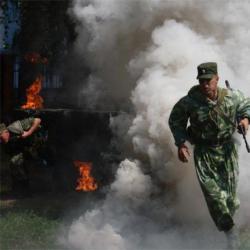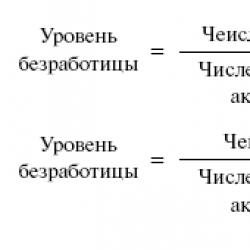Military pensioners stand for Russia and its armed forces. HOA Amber Increase in the cost of utilities in the year
The increase in prices for services will not exceed the planned inflation rate
Moscow approved an increase in utility tariffs from July 1, 2016: for heating - by 8.1%; for cold water and wastewater disposal - by 7%; for hot water supply - by 7.8%; for electricity - by 7–15% (depending on the time of consumption); for gas - by 2% (see table).
In addition, an increase in fees for the maintenance and repair of residential premises is envisaged: by 4% for non-subsidized areas (area in excess of established standards, “second housing”) and by 15% for areas within social standards (subsidized housing).
As noted by the mayor’s office, “the weighted average growth rate of tariffs for housing and communal services will be 7.4%, which is lower than the forecast inflation rate for 2016 (8.1%),” while benefits and subsidies for payment of services for certain categories of citizens will remain in in full.
It would seem that you would think - pennies and rubles, but people count them, because there are dozens of such items of expense in their personal households, and the result is a significant reduction in the financial viability of citizens.

Back in the fall, the head of the Ministry of Labor of the Russian Federation, Maxim Topilin, estimated the decline in real incomes of Russians in 2015 by 4–5%. In turn, experts in the analysis of consumer behavior note that the “sweet life” of Muscovites has already become more insipid: they are forced to reduce foreign trips, trips to shopping centers, save on cafes and restaurants, and the services of hairdressers and cosmetologists.
Of course, if you remember that the minimum wage will increase to 6,204 rubles from January 2016 (from the current 5,965 rubles), on this occasion you can even drink a celebratory glass in the heat of the moment. But I don't want to have fun.
According to our monitoring, over the three quarters of 2015, real incomes of the population of the Russian Federation fell by 3.3%, and wages by 9%, that is, working people lost almost a tenth of their earnings - this is the most serious decline since 1998,” she explained "MK" senior researcher at the Center for Analysis of Income and Living Standards of the Higher School of Economics Svetlana Biryukova. - Pensions fell by 4%, which was also a big shock for older people, who had become accustomed to its growth in recent years. The turnover of retail trade in food products fell by almost 10%, and the turnover of non-food products decreased by approximately 11%. Unfortunately, our income forecast is not very good; we do not see any recovery trend. And, of course, a 7% increase in tariffs will create additional stress for Muscovites. Well, any increase in the minimum wage leads to the displacement of part of the employed from the labor market, since the employer has to revise its budget.
State Budgetary Institution “Zhilishchnik of the Matushkino District” notifies about changes in prices, rates and tariffs from 07/01/2016 in accordance with the Decree of the Moscow Government of December 15, 2015 N 889-PP “ON APPROVAL OF PRICES, RATES AND TARIFFS FOR HOUSING AND UTILITY SERVICES FOR POPULATION"
FOR COLD WATER AND WATER DISPOSAL
for the population of Moscow
TARIFFS FOR THERMAL ENERGY (HEATING) for the population of Moscow
|
Name of company |
Tariffs for thermal energy for the population of Moscow, including VAT (rubles/Gcal) |
|
|
Public Joint Stock Company of Energy and Electrification "Mosenergo" - tariff for thermal energy production | ||
|
Public Joint Stock Company "Moscow United Energy Company" - tariff for services for the transmission of thermal energy through trunk networks | ||
|
Public Joint Stock Company "Moscow United Energy Company" and other organizations - tariff for thermal energy (purchase, production, transmission of thermal energy through heating networks, taking into account the costs of maintaining heating networks (central heating points, thermal inputs, pumping stations) |
TARIFFS FOR 2016 IN MOSCOW FOR HOT WATER for the population of Moscow
PRICES FOR MAINTENANCE OF RESIDENTIAL PREMISES
|
for the area occupied within the established standards, for tenants of residential premises owned by the city of Moscow and provided under a social tenancy agreement or a lease agreement for specialized residential premises, for citizens - users of residential premises owned by the city of Moscow and provided for use under a contract of gratuitous use, and for citizens - owners of residential premises who have a single residential premises and are registered in it (in rubles per 1 sq. m of total living area per month, including VAT) |
for the area occupied in excess of the established standards, for tenants of residential premises owned by the city of Moscow and provided under a social tenancy agreement or a lease agreement for specialized residential premises, for citizens - users of residential premises owned by the city of Moscow and provided for use under agreement for free use, for citizens - owners of residential premises, having a single residential premises and registered in it, citizens - owners of residential premises, having more than one residential premises or not registered in it, and for tenants under a rental agreement for residential premises of a housing stock for commercial use ( in rubles per 1 sq. m of total living space per month, including VAT) |
||||
|
for residential premises located on the second and subsequent floors of the house |
for residential premises located on the ground floor of the house |
||||
|
Apartment buildings: |
|||||
|
Residential buildings with all amenities, with an elevator and a garbage chute | |||||
|
Residential buildings with all amenities, with an elevator, without a garbage chute | |||||
|
Residential buildings with all amenities, without an elevator, with a garbage chute | |||||
|
Residential buildings without one or more types of amenities or with wear and tear of 60 percent or more | |||||
|
Low-rise buildings of the Moscow housing stock: |
|||||
|
Residential buildings with all amenities, no elevator, no garbage chute | |||||
INFO about changing the rental fee
RATES OF PAYMENT FOR SOCIAL LEASE OF RESIDENTIAL PREMISES AND RENTALS
SPECIALIZED RESIDENTIAL PREMISES
for citizens (families of citizens) entitled to benefits for housing and communal services,
as well as for citizens (families of citizens) receiving subsidies for housing and communal services
RATES OF PAYMENT FOR SOCIAL RENTAL OF RESIDENTIAL PREMISES AND RENTAL OF SPECIALIZED RESIDENTIAL PREMISES
RATES OF PAYMENT FOR COMMERCIAL RENTAL OF RESIDENTIAL PREMISES
FEE RATE FOR RENTING RESIDENTIAL PREMISES IN NON-SUPPORT HOUSES
The Regional Energy Commission of the City of Moscow adopted Resolution No. 432-v “On the establishment of tariffs for drinking water and wastewater disposal for consumers of the Mosvodokanal joint-stock company for 2016” on December 18, 2015.
Tariffs for drinking water and sanitation provided to Moscow residents are divided into 4 consumer groups:
- Population.
- Budgetary organizations.
- Owners of non-residential premises.
- Organizations of water supply and sewerage services in the region.
Tariffs for water and sewerage in Moscow for 2016 (except for the Troitsky and Novomoskovsky districts)
| Consumers | Period | Tariffs for drinking water, rub./cub.m. | Tariffs for water disposal, rub./cub.m. |
|---|---|---|---|
| Population (including VAT) | from 01/01/2016 to 06/30/2016 | 30,87 | 21,9 |
| from 1.07.2016 to 31.12.2016 | 33,03 | 23,43 | |
| Budgetary organizations | from 01/01/2016 to 06/30/2016 | 26,16 | 18,56 |
| from 1.07.2016 to 31.12.2016 | 27,99 | 19,86 | |
| from 01/01/2016 to 06/30/2016 | 28,17 | 19,46 | |
| from 1.07.2016 to 31.12.2016 | 28,65 | 19,9 | |
| Regional water supply and sewerage organizations | from 01/01/2016 to 06/30/2016 | 21,5 | 17,67 |
| from 1.07.2016 to 31.12.2016 | 21,93 | 18,34 |
As can be seen from the table, the last increase in water tariffs was on July 1, 2016. The price increase was planned and adjusted according to the program of socio-economic development of Moscow until 2018.
Tariffs for water and sewerage in the Troitsky and Novomoskovsky districts
| Name of centralized water supply and sanitation systems in the territories of intra-city municipalities of Moscow |
Name of consumers |
Tariffs (RUB/m3) |
||
|---|---|---|---|---|
| Cold water | Water disposal | |||
| 1 | Shcherbinka urban district | Population (including VAT) | 18,30 | 22,24 |
| Other consumers** | 15,51 | 18,85 | ||
| 2 | Population (including VAT) | 34,17 | 31,97 | |
| Other consumers** | 28,96 | 27,09 | ||
| 3 | Population (including VAT) | 23,52 | 30,29 | |
| Other consumers** | 19,93 | 25,67 | ||
| 4 | Population (including VAT) | 19,23 | 31,41 | |
| Other consumers** | 16,30 | 26,62 | ||
| 5 | Population (including VAT) | 20,40 | 22,97 | |
| Other consumers** | 17,29 | 19,47 | ||
| 6 | Settlement Ryazanovskoye | Population (including VAT) | 17,63 | 23,27 |
| Other consumers** | 14,94 | 19,72 | ||
| 7 | Troitsk urban district | Population (including VAT) | 20,17 | 24,10 |
| Other consumers** | 17,09 | 20,42 | ||
| 8 | Population (including VAT) | 27,80 | 23,18 | |
| Other consumers** | 23,56 | 19,64 | ||
|
Name of centralized water supply and sanitation systems in the territories of intra-city municipalities of Moscow |
Name of consumers |
Tariffs (RUB/m3) |
||
| Cold water | Water disposal | |||
| 1 | Shcherbinka urban district | Population (including VAT) | 19,59 | 23,80 |
| Other consumers** | 16,60 | 20,17 | ||
| 2 | Settlements Moskovsky, Vnukovskoye, Voskresenskoye, Desenovskoye, Mosrentgen, Sosenskoye, Filimonkovskoye | Population (including VAT) | 34,17 | 34,21 |
| Other consumers** | 28,96 | 28,99 | ||
| 3 | Settlements Shchapovskoye, Klenovskoye | Population (including VAT) | 25,17 | 32,41 |
| Other consumers** | 21,33 | 27,47 | ||
| 4 | The settlements of Voronovskoye, Krasnopakhorskoye (with the exception of the village of Minzag), Mikhailovo-Yartsevskoye, Rogovskoye | Population (including VAT) | 20,58 | 33,61 |
| Other consumers** | 17,44 | 28,48 | ||
| 5 | Minzag subsistence village of Krasnopakhorskoe settlement | Population (including VAT) | 21,83 | 24,58 |
| Other consumers | 18,50 | 20,83 | ||
| 6 | Settlement Ryazanovskoye | Population (including VAT) | 18,87 | 24,90 |
| Other consumers** | 15,99 | 21,10 | ||
| 7 | Troitsk urban district | Population (including VAT) | 21,58 | 25,79 |
| Other consumers** | 18,29 | 21,86 | ||
| 8 | Settlements Kyiv, Pervomaiskoye, Novofedorovskoye, Kokoshkino, Marushkinskoye | Population (including VAT) | 29,75 | 24,79 |
| Other consumers** | 25,21 | 21,01 | ||
* — Resolution of the Regional Energy Commission of the city of Moscow dated December 18, 2015 No. 432-v came into force on January 1, 2016.
The tariff for hot water was adopted by Resolution No. 545-gv “On the establishment of tariffs for hot water (hot water supply) supplied by the joint-stock company “Main Directorate of Housing and Communal Services” to consumers using closed hot water supply systems for 2016”
Tariffs for hot water in the city of Moscow, with the exception of the Troitsky and Novomoskovsky administrative districts of the city
| Consumers | Period | Tariffs, rub./cub.m. |
|---|---|---|
| Population (including VAT) | from 01/01/2016 to 06/30/2016 | 134,6 |
| from 1.07.2016 to 31.12.2016 | 143,76 | |
| Providers of utility services | from 01/01/2016 to 06/30/2016 | 114,07 |
| from 1.07.2016 to 31.12.2016 | 121,83 | |
| Budgetary organizations | from 01/01/2016 to 06/30/2016 | 126,1 |
| from 1.07.2016 to 31.12.2016 | 134,68 | |
| Organizations, owners of non-residential buildings | from 01/01/2016 to 06/30/2016 | 128,11 |
| from 1.07.2016 to 31.12.2016 | 135,06 |
As can be seen from the table, in Moscow the price of hot water is higher than in the Troitsky and Novomoskovsky districts. It can be noted that since July 1, 2016, prices for hot water have increased by an average of 5%.
Tariffs for hot water in the Troitsky and Novomoskovsky districts
| Name of the centralized hot water supply system | Period | Tariffs for other consumers, rub./cub.m. | Tariffs for the population, rub./cub.m. |
|---|---|---|---|
| Settlement "Mosrentgen" (village of Mamyri) | from 01/01/2016 to 06/30/2016 | 71,45 | 84,31 |
| from 1.07.2016 to 31.12.2016 | 76,01 | 89,69 | |
| Settlement "Mosrentgen" (village of the Mosrentgen plant) | from 01/01/2016 to 06/30/2016 | 89,03 | 105,06 |
| from 1.07.2016 to 31.12.2016 | 94,85 | 111,92 | |
| Settlement Shchapovskoye | from 01/01/2016 to 06/30/2016 | 76,40 | 90,15 |
| from 1.07.2016 to 31.12.2016 | 82,17 | 96,96 | |
| Settlement Krasnopakhorskoye | from 01/01/2016 to 06/30/2016 | 79,02 | 93,24 |
| from 1.07.2016 to 31.12.2016 | 83,84 | 98,93 | |
| Settlement Pervomaiskoe | from 01/01/2016 to 06/30/2016 | 98,16 | 115,82 |
| from 1.07.2016 to 31.12.2016 | 104,81 | 123,68 | |
| Settlement Desenovskoye | from 01/01/2016 to 06/30/2016 | 71,31 | 84,15 |
| from 1.07.2016 to 31.12.2016 | 75,56 | 89,16 |
Tariffs for process water for consumers of Mosvodokanal JSC
* — Resolution of the Regional Energy Commission of the city of Moscow dated December 18, 2015 No. 432-v came into force on January 1, 2016;
** — tariffs do not include value added tax
TARIFFS FOR 2016 IN MOSCOW
FOR MAINTENANCE AND REPAIR OF RESIDENTIAL PREMISES
Rates of planned and normative expenses for calculating the amount of subsidies provided to organizations managing apartment buildings from the budget of the city of Moscow for the maintenance and current repairs of common property in an apartment building, with the exception of apartment buildings located on the territory of the Troitsky and Novomoskovsky administrative districts of the city of Moscow, residential premises in which are municipally owned or owned by citizens
|
N |
Rates of planned and standard expenditure (rubles per month per 1 sq.m. of total residential area) |
||
|
Residential buildings with elevator and garbage chute |
|||
|
Residential buildings with an elevator, without a garbage chute |
|||
|
Residential buildings without an elevator, with a garbage chute |
|||
|
Residential buildings without an elevator, without a garbage chute |
|||
TARIFFS FOR 2016 IN MOSCOW FOR MAINTENANCE AND REPAIRS IN NON-DOTATION HOUSES
The rate of payment for the use of residential premises owned by the city of Moscow for tenants of residential premises under a rental agreement for residential premises in non-subsidized buildings of the housing stock of the city of Moscow (rate of payment for the rental of residential premises in non-subsidized buildings)
TARIFFS FOR 2016 IN MOSCOW FOR MAINTENANCE AND REPAIRS IN DONATION HOUSES (MUNICIPAL APARTMENTS)
Prices for the maintenance of residential premises for tenants of residential premises owned by the city of Moscow and provided for use under a social rental agreement for residential premises, a rental agreement for specialized residential premises and a rental agreement for residential premises for commercial use; for citizen users of residential premises owned by the city of Moscow and provided for use under a free use agreement; for citizens who are owners of residential premises in apartment buildings located on the territory of the city of Moscow, if at the general meeting of owners of the premises of an apartment building in the prescribed manner a decision was not made to establish the amount of payment for the maintenance of residential premises, with the exception of the population living in residential premises located in municipal property and property of citizens, on the territory of the Troitsky and Novomoskovsky administrative districts of Moscow (prices for the maintenance of residential premises)
|
for the area occupied within the established standards, for tenants of residential premises owned by the city of Moscow and provided under a social tenancy agreement or a lease agreement for specialized residential premises, for citizens - users of residential premises owned by the city of Moscow and provided for use under a contract of gratuitous use and for citizens - owners of residential premises who have a single residential premises and are registered in it (in rubles per 1 sq.m. of the total area of the residential premises per month, including VAT) |
for the area occupied in excess of the established standards, for tenants of residential premises owned by the city of Moscow and provided under a social tenancy agreement or a lease agreement for specialized residential premises, for citizens - users of residential premises owned by the city of Moscow and provided for use under agreement for free use, for citizens - owners of residential premises, having a single residential premises and registered in it, citizens - owners of residential premises, having more than one residential premises or not registered in it, and for tenants under a rental agreement for residential premises of a housing stock for commercial use ( in rubles per 1 sq.m. of total living space per month, including VAT) |
|||||||
|
for residential premises located on the second and subsequent floors of the house |
for residential premises located on the ground floor of the house |
|||||||
|
Apartment buildings: |
||||||||
|
Residential buildings with all amenities, with an elevator and a garbage chute |
||||||||
|
Residential buildings with all amenities, with an elevator, without a garbage chute |
||||||||
|
Residential buildings with all amenities, without an elevator, with a garbage chute |
||||||||
|
Residential buildings without one or more types of amenities or with wear and tear of 60 percent or more, as well as residential premises (apartments) recognized in accordance with the established procedure as unsuitable for habitation |
||||||||
|
Low-rise buildings of the Moscow housing stock: |
||||||||
|
Residential buildings with all amenities, no elevator, no garbage chute |
||||||||
TARIFFS FOR 2016 IN MOSCOW FOR COLD WATER AND WATER DISPOSAL
for the city population
Moscow, with the exception of the population living
on the territory of Troitsky and Novomoskovsky
administrative districts of Moscow
TARIFFS FOR 2016 IN MOSCOW FOR HOT WATER
for the population of the city of Moscow, with the exception of
population living on the territory of Trinity
and Novomoskovsky administrative districts of Moscow
TARIFFS FOR 2016 IN MOSCOW FOR THERMAL ENERGY (TARIFFS 2016 FOR HEATING)
for the population of Moscow,
with the exception of the population living in the territory
Troitsky and Novomoskovsky administrative districts
Moscow cities
|
No. |
Name of company |
Tariffs for thermal energy for the population of Moscow, including VAT (rubles/Gcal) |
|
|
OJSC "Mosenergo" - tariff for thermal energy production |
|||
|
OJSC "MOEK" - tariff for services for the transmission of thermal energy through trunk networks |
|||
|
OJSC "MOEK" and other organizations - tariff for thermal energy (purchase, production, transmission of thermal energy through heating networks, taking into account the costs of maintaining heating networks (central heating points, thermal inputs, pumping stations) |
|||
TARIFFS FOR 2016 IN MOSCOW FOR NATURAL GAS
retail prices for natural gas for settlements with the population of the city of Moscow, with the exception of the population living in the territory of the Troitsky and Novomoskovsky administrative districts of the city of Moscow
|
N |
Type of household gas-using equipment |
Retail price including VAT (rubles/cubic meter) |
|
|
If the apartment has a gas stove and centralized hot water supply |
|||
|
If the apartment has a gas stove and a gas water heater (in the absence of a centralized hot water supply) |
|||
|
If there is a gas stove in the apartment and there is no centralized hot water supply and gas water heater |
|||
|
Houses heated by gas heaters |
|||
TARIFFS FOR 2016 IN MOSCOW FOR ELECTRICITY (LIGHT, ELECTRICITY)
for electrical energy supplied by energy sales organizations to the population of the city of Moscow, with the exception of the population living in the territory of the Troitsky and Novomoskovsky administrative districts of the city of Moscow
|
N |
Indicator (consumer groups broken down by rates and differentiated by day zones) |
Unit |
Rate |
|
|
Population (tariffs include VAT) |
||||
|
Population, with the exception of those specified in paragraph 2 of this appendix |
||||
|
One-part tariff |
rubles/kWh |
|||
|
Day zone |
rubles/kWh |
|||
|
Night zone |
rubles/kWh |
|||
|
Peak zone |
rubles/kWh |
|||
|
Half-peak zone |
rubles/kWh |
|||
|
Night zone |
rubles/kWh |
|||
|
Population living in urban settlements in houses equipped in the prescribed manner with stationary electric stoves and (or) electric heating installations (tariffs are indicated including VAT) |
||||
|
One-part tariff |
rubles/kWh |
|||
|
Tariff differentiated by two zones of the day |
||||
|
Day zone |
rubles/kWh |
|||
|
Night zone |
rubles/kWh |
|||
|
Tariff differentiated by three zones of the day |
||||
|
Peak zone |
rubles/kWh |
|||
|
Half-peak zone |
rubles/kWh |
|||
|
Night zone |
rubles/kWh |
|||
The growth of utility tariffs in the capital this year is unlikely to be higher than inflation - it is predicted to be approximately 7-8%, and prices for utilities will also rise. Heating will rise in price the most - by 8.1%, hot water supply - by 7.8%, cold water and sanitation - by 7%, electricity - by 7-15% (depending on the availability of an electric stove and the type of meter), gas - by 2%.
It is quite difficult to calculate how much the final figure in payments will rise, since in each case it will be different. In any case, we are talking about several hundred rubles, and then everything depends on the size of the apartment and the number of residents. According to the head of the Moscow Department of Economic Policy and Development, Maxim Reshetnikov, on average, one Muscovite will start paying 200 rubles more from July 1. “This is an average level. Of course, everyone has their own pattern of consumption of these services, so the numbers in each payment bill are different,” he noted.
Benefits will remain
The authorities will retain all existing benefits and subsidies - the capital’s budget will spend more than 30 billion rubles on compensation for benefits. In total, there are 3.3 million people receiving utility benefits in the capital, and if you add to them those who use subsidies to pay for housing and communal services, it turns out that every third Muscovite uses benefits. In total, there are 48 preferential categories in the city; discounts on utility bills for them range from 30% to 100%, the mayor’s office reported.
In addition to benefits, there are also subsidies, which are often received by economically active, working people. The average payment is 2 thousand rubles, and more than 600 thousand Moscow families receive it - and their number increases every year. Every family whose utility costs exceed 10% of its total income is entitled to subsidies. This is the lowest bar in Russia. In St. Petersburg, for example, payments are due only to those whose payments “eat up” more than 14% of their budget, and in the Moscow region and other regions - 22%.
Calculating whether you are eligible for a subsidy is simple. If a family of three has a total monthly income below 86.1 thousand rubles, hurry to apply for a subsidy. If there are only two people in your family, and your income does not exceed 61.7 thousand rubles, then you also have the right to compensation for utility costs. Finally, if you live alone and earn less than 39.8 thousand rubles, then you are also covered by benefits.
Keep an eye on the counter
Despite the rather high tariffs, Muscovites still do not pay the full cost of some services. The city, for example, subsidizes tariffs for heating and hot water - the most expensive resources. In addition, the budget assumes the provision of benefits and the payment of subsidies, maintenance and improvement of courtyards, ensuring the operation of elevator control rooms and an automated payment system for housing and communal services. As a result, the city pays for every third ruble associated with utility costs. “In the total amount of spending on housing and communal services, the population accounts for 204 billion rubles, and the city budget accounts for 94 billion,” the press service of the Department of Economic Policy and Development explained to RG.
The city's participation removes quite large costs from the shoulders of citizens. For example, only in Moscow the replacement and maintenance of communal meters is carried out at the expense of the budget. In other regions, these costs are covered from the wallets of residents.
However, Muscovites themselves also try to save money and not pay extra. Today, cold and hot water meters are installed in almost all apartments - according to the mayor's office, 83% of the city's housing stock is equipped with them. In particular, thanks to this, the volume of cold water consumption in the metropolis has decreased by 21% since 2010. And over the past 20 years, Muscovites have begun to pour half as much water - today there are 147 liters per city resident per day, and in the mid-90s the figure reached 300.
Good to know
To apply for a subsidy, you need to provide the following documents: passports of the applicant and family members, income certificates for all household members and details of the bank account or social card of the Muscovite, where the subsidy will be transferred. A certificate of income for the last six months, and if there is nowhere to get it, you will need a paper confirming the lack of income. For example, a certificate of absence of a scholarship or a document from the employment center confirming that the unemployed does not receive any payments. Only non-working pensioners do not need to document income.





